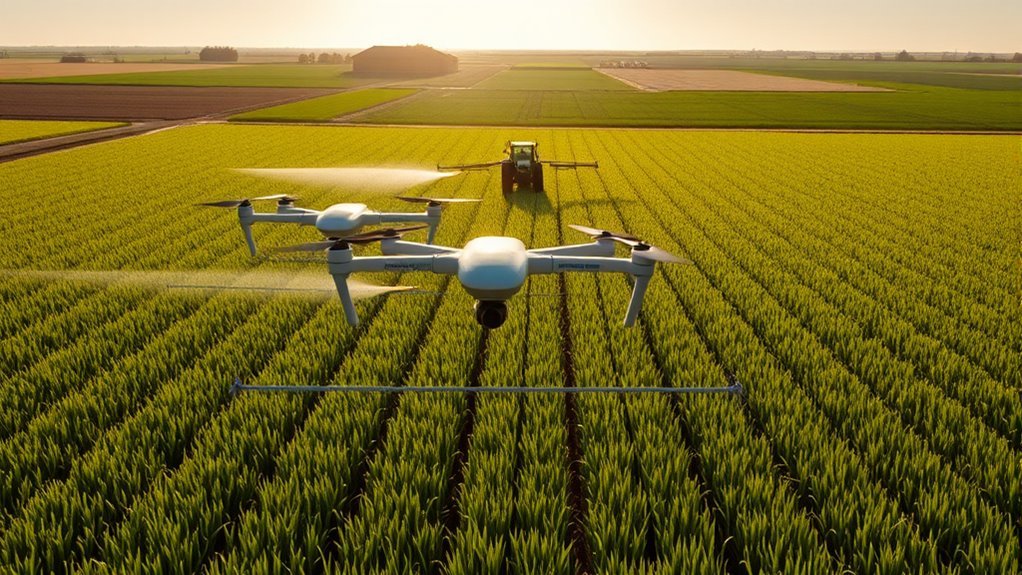You’ll find that Guardian Agriculture’s drones slash your farming costs by automating crop monitoring, which cuts labor expenses through real-time sensor assessments. Precision spraying minimizes chemical waste, optimizing resource use and reducing water consumption by up to 30%. They streamline pest control for targeted treatments, lowering maintenance fees over time. Explore these efficiencies further to enhance your farm’s bottom line.
Key Points
- Drones automate crop monitoring, reducing labor costs and manual inspections.
- Precision spraying minimizes chemical usage, lowering costs per acre.
- Optimized resource allocation cuts water and fuel expenses by up to 30%.
- Early pest detection enables targeted treatments, reducing intervention costs.
- Streamlined maintenance lowers repair expenses by up to 30% long-term.
Automating Crop Monitoring to Cut Labor Expenses
By automating crop monitoring with Guardian Agriculture’s drones, you’ll reduce labor expenses considerably. These drones employ advanced sensors to assess crop health in real-time, freeing you from manual inspections that once demanded hours of fieldwork. You’ll achieve greater labor efficiency by deploying drones across vast areas, capturing data on plant health without human intervention, thereby minimizing staffing needs.
In practice, integrating these drones lets you schedule flights autonomously, ensuring consistent monitoring that enhances decision-making. For instance, early detection of crop health issues allows targeted interventions, optimizing your operations without extra hands. This technology empowers you to reclaim time, fostering independence from labor-intensive routines and boosting overall farm productivity. By prioritizing efficiency, you’ll maintain control over your resources, turning routine tasks into streamlined processes that support sustainable growth. With drones handling the heavy lifting, you’re liberated to focus on strategic aspects of your enterprise.
Precision Spraying for Reduced Chemical Costs
You’ll cut chemical costs effectively with Guardian Agriculture’s precision spraying technology, which uses drones to target applications precisely. This targeted application guarantees chemicals reach only where needed, boosting chemical efficiency by minimizing waste and overuse. You’ll gain control over your fields, applying pesticides or fertilizers with pinpoint accuracy via drone sensors that analyze crop health in real-time, reducing runoff and environmental harm.
| Factor | Traditional Spraying | Precision Spraying with Drones |
|---|---|---|
| Application Accuracy | Inconsistent coverage | High precision targeting |
| Chemical Efficiency | High waste and overuse | Optimized, reduced usage |
| Cost Per Acre | Elevated due to excess | Lower through targeted application |
| Operational Speed | Slower, labor-intensive | Faster, autonomous flights |
| Field Autonomy | Limited operator control | Enhanced freedom for you |
Optimizing Resource Use in Field Operations
Optimizing resource use in field operations hinges on Guardian Agriculture’s drones, which streamline inputs like water, fuel, and labor through advanced analytics. You’ll leverage data analytics to monitor field conditions in real-time, enabling precise resource allocation that minimizes waste and boosts efficiency. For instance, these drones analyze soil moisture and crop health data, allowing you to allocate water only where it’s needed, cutting consumption by up to 30%. When it comes to fuel, integrated algorithms optimize flight paths, reducing unnecessary trips and lowering your operational costs. Labor-wise, you’re freed from manual monitoring; automated reports let you reassign workers to higher-value tasks, enhancing productivity without overextension. This approach empowers you to manage your farm autonomously, ensuring sustainable, cost-effective operations that put you in control of your resources. By prioritizing smart resource allocation, you’re not just saving money—you’re reclaiming your freedom to innovate.
Streamlining Pest Control to Lower Maintenance Fees
Guardian Agriculture’s drones tackle pest control by deploying real-time monitoring and targeted interventions, helping you slash maintenance fees. With advanced sensors, you’ll detect pest outbreaks early, enabling precise, targeted treatments that apply only what’s needed—saving resources and minimizing environmental impact. This means reduced intervention overall, as drones identify and address issues before they escalate, cutting down on manual checks and chemical overuse.
As a farmer seeking freedom from costly routines, you gain control through automated scouting that integrates seamlessly with your operations. For instance, drones map infestations in real time, allowing you to deploy treatments via precise spraying, which lowers labor costs and prevents widespread damage. By focusing on efficiency, you’ll maintain healthier crops with less effort, transforming pest management into a streamlined, cost-effective process that puts you in charge.
Long-Term Savings From Efficient Drone Integration
As you integrate drones efficiently into your farming operations, you’ll realize substantial long-term savings by minimizing ongoing expenses and enhancing resource efficiency. Through robust data analysis of aerial imagery and sensor data, you’ll identify inefficiencies in real-time, optimizing fertilizer and water use to cut waste and boost yields without over-reliance on traditional methods. This empowers you to make autonomous decisions, freeing your operations from costly guesswork. Meanwhile, streamlined drone maintenance—such as scheduled diagnostics and firmware updates—ensures longevity and reliability, reducing repair costs by up to 30% over time. By prioritizing these practices, you’re liberating your farm from downtime and unexpected expenses, fostering a self-sustaining model. Regular performance reviews via data analysis further refine strategies, preventing resource overuse and promoting adaptive, cost-effective farming. Ultimately, this integration delivers enduring financial freedom, letting you scale operations independently while maintaining peak productivity.

